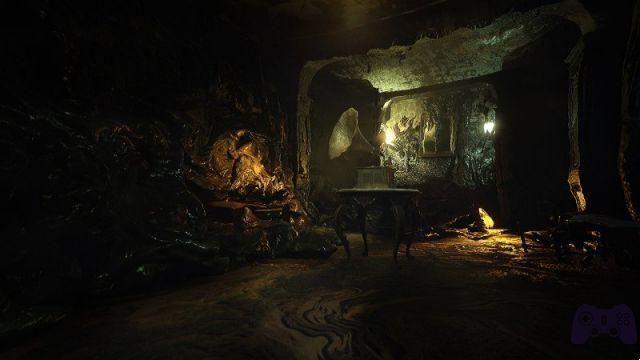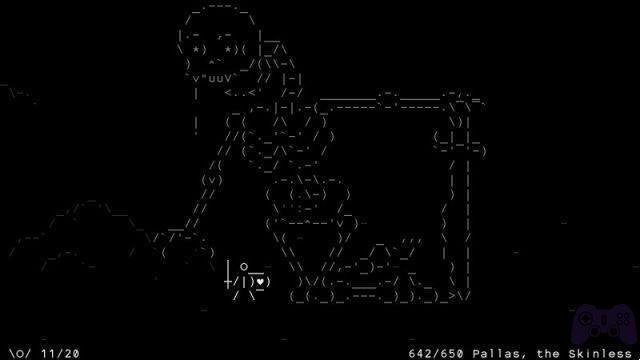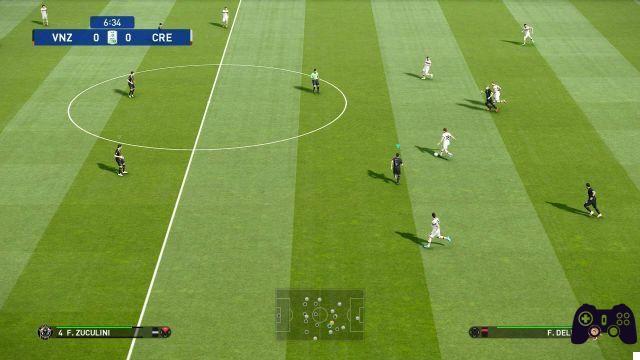When you get to work on a challenging task like starfield review It is very easy to fall into the temptation of putting aside the gamer instinct of running straight to the goal and completing your mission, trying to become almost impervious to the universe that orbits the avatar. But the truth is that the worlds built by Bethesda Softworks only take a handful of seconds before slapping you a couple of times and reminding you how silly that approach is. Just think of the famous path that connects the small town of Riverwood to Whiterun Hill in Skyrim: the atmosphere is caressed by the roar of a stream, a deer cautiously crosses the path and, suddenly, the foliage of the forest parts, revealing a huge network of adventures wrapped in the embrace of the mountains. How can you even think of being able to run in a context like this? Simple: it's usually not possible.
So we have just returned aboard the Reason, a warship assembled module by module, which narrowly escaped the attack of the insectoid swarm that had invaded a mining platform on the Eridani IV pole. Until recently, we were running through the fluorescent alleys of Neon City, embroiled in a cruel gang war, until everything changed after a chance encounter in a tavern, which lifted the curtain on a weeks-long investigation, an investigation that took us led to chasing a group of veterans across dozens of star systems. We have been spies, pirates, explorers, assassins, explorers. We sat in boardrooms and drank in spaceports with the worst criminals. We've been on both sides of a laser rifle, a wad of credits, an interrogation room. And perhaps it is precisely between the pages of this logbook where the secret to the success of video games is hidden: these are interactive works that allow impossible lives to be lived on the other side of the screen.
Building worlds, laying the foundations for alternative existences, giving tangible form to the classic escape from reality. It is a mantra that a store in Maryland has been repeating for years, a development studio like many others, if it were not for the fact that simple products are not packaged between cubicles and meeting rooms: entire universes are forged. Mosaics of events, characters and places capable of infusing a rare spark of life into the heart of our digital selves, as happened first in the regions of The Elder Scrolls and then in the nuclear winter of Fallout. But there is a third virtual world that has been wandering through the corridors of those studios for years, tickling the imagination of Todd Howard and the pens of the most historical authors, a mysterious "game in space" that for time immemorial remained as a banal dream locked away. In a drawer, a name written on a blackboard: Starfield. The third soul of Bethesda Softworks, the epic adventure among the stars, one that would have been impossible to achieve without the right technologies.
However, there is one huge and colossal difference compared to the past: Starfield is not a single virtual world built entirely by hand, but a slice of the galaxy that houses hundreds of worlds, loading players into a spaceship with the promise impossible to give them. An unforgettable space odyssey. Up there, drifting among the stars, we discover a video game with a double soul, sustained by great ambition but precisely for that reason forced to make great commitments, projected towards the future but the result of a recipe strongly rooted in the past. What matters, on the other hand, is that Bethesda's purpose remains the one that drove it to success: to tell an alternative life, this time in the recesses of the Milky Way.
Marco: beyond the one world
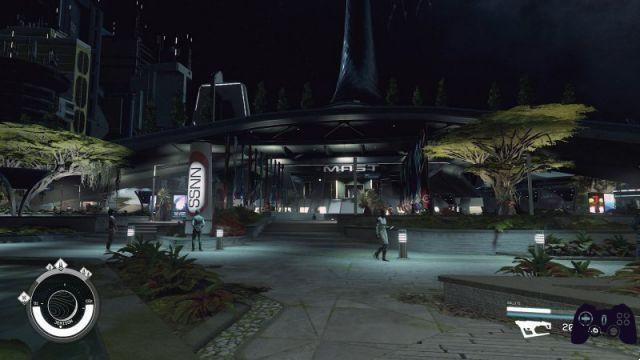
If there's one thing Bethesda artists are and always will be masters at, it's that world building. Starfield takes shape in a fraction of the galaxy known as the Colonized Systems, the group of a hundred stars that have long become the new home of the human species. However, there is an old saying about war that never changes: in fact, it was only a handful of years before the exiles of the Solar System took up arms and divided into warring factions. The largest are the United Colonies and the independentists of the Freestar Collective, two powers that inflamed the sidereal void through the great Colonial War, whose scars still remain engraved in the dozens of abandoned war structures, as well as in the hearts of veterans and civilians. . This fracture was reflected in the design at the base of the settlements, of the clothing, of everything that characterizes the different celestial vaults: if the New Atlantis is a modern and vibrant, clean and sinuous metropolis, the city of Akila in the center of the Freestar system is presented as a town that seems to have emerged from the frontier of the far west, patrolled by the ranger corps and surrounded by monumental canyons.
And then there is Neon, a lawless cyberpunk eco-monster in which "rats" fight to survive in the shadow of giant corporations, or Cydonia, a very poor mining settlement that like an anthill devours the surface of Mars. There are dozens of armed groups, autonomous settlements, spaceports that dot the celestial vault: there are space stations converted into black market headquarters for unscrupulous pirates, there are metropolises plagued by invasions of xenophobic weapons, there are even dream planetary resorts like Paradiso. , or even traveling hospitals like the Clinic, along with dozens of other places that Atmospheres change constantly, the topics covered and the artistic inspirations.
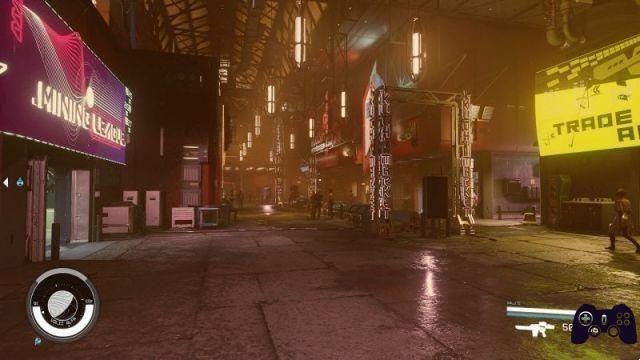
Although there has often been talk of a "NASApunk" influence, Starfield's greatest strength lies in its variety of different fantasies to which he managed to give free rein, combining exquisitely vintage designs with impossible architecture, utopian cities with ruined slums. It is a work that constantly mixes the old and the new in the context of a world that manages to be at the same time Western, cyberpunk, horror, new wave, equally open to the dynamics of science fiction and some forays into ethics, integrating some options that can nail you in front of the screen: what would you be willing to sacrifice to cross the new frontier of progress?
At a certain moment, the other side of Starfield emerges, the most hidden, most intimate, rooted in the silences of space. That of red stones heated by distant stars, of planetoids with infernal temperatures on which radioactive lightning rains, of primordial biomes struck by the claws of amphibians and dinosaurs. That's when the evolution of the Creation Engine comes into its own, generating icy mountain ranges and ocean panoramas, biospheres teeming with life and rocky deserts where you couldn't hear a fly flying, if it weren't for Inon's majestic soundtrack. The ancient war architecture continually stands out against unknown skies, caressed by the lights of violet sunsets that manage to give life to real landscapes. postcards from space. At the same time, almost ironically, it is precisely space that emerges as the greatest limit of Bethesda's new production.
Exploration: too many commitments for a sea of stars
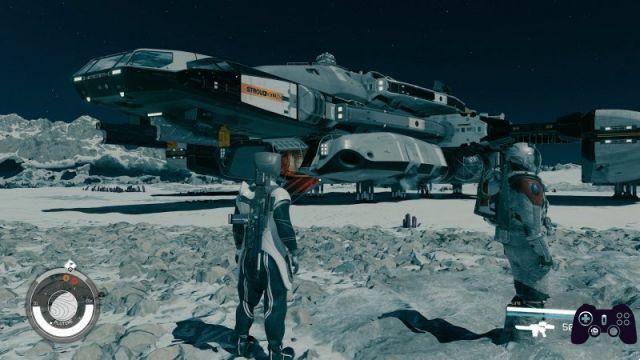
The beating heart and soul of any experience born of study usually lies inexploration, silent engine behind the adventures that have frescoed the backgrounds of each work in the house; Starfield, for its part, demolishes this paradigm, outlining a universe in which the missions find the player and not the other way around, completely changing the way of approaching the world and - in a way - sacrifice the element of discovery. Space exploration is simply carried out passively: the spaceship available to the protagonist is actually configured as a kind of platform for fast travel, since it is not possible to pilot it along the surface during takeoff and landing, during the trip within the same star. system and obviously during the gravitational jump. Each of these operations is always accompanied by access to the map, a movie and an old-fashioned load, in a way that is diametrically opposed to what other video games set among the stars encode, especially No Man's Sky.
The only time you really put your hand on the control stick is when you are in orbit around a single planet or a space station, which is the setting chosen by Bethesda to stage its classic random encounters: only in these situations does interaction happen. with other ships, engage in piracy, shoot down potential attackers, or rescue star castaways, effectively relegating the entire flight system exclusively to these tiny parentheses. This means that it is not possible to navigate into the unknown with the aim of really discovering something significant, of identifying at first glance a complex that captures attention and landing next to it, but rather simply of exploring the scenarios in an organic way: You always have to trust in individual missions and in marks visible directly on the map, the only tools that can guide the astronaut to destinations that are really worth visiting.
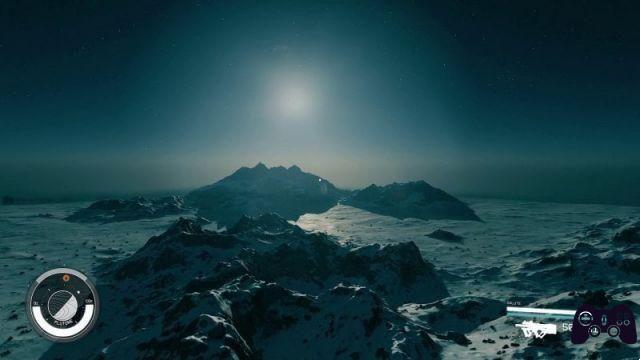
Things change completely when you land on a planet, but not necessarily for the better: once you have taken the first steps into unknown terrain - that is, very large areas delimited by invisible borders - around the spacecraft procedurally generated a series of points of interest and structures built by hand by the in-house artists, to fill the spaces of such an exaggerated world. This means that, walking a few kilometers in the void of any celestial body, you will find abandoned mining platforms, disused laboratories, small caves and research towers. In the first moments of the adventure it is like witnessing a fascinating magic: the opportunity to experience emergent situations in the midst of majestic panoramas can generate powerful sequences and moments of great impact, but the spell ends up dissolving after a handful of hours, as as soon as the inevitable repetitiveness of architecture begins to come into play.
These points of interest do not simply tend to they repeat themselves as they are incessantly, constantly returning with the same plan and the same positioning of objects, but they also end up invading the framework of the main mission. The result is that it may happen that you come across a "Cryolaboratory" three, five, even ten times exactly the same as all those previously visited, even among the destinations where events related to the plot take place, quickly emptying it of any concrete content. meaning and rewarding the exploration of the planetary surface. But there is another side effect, in some ways even more cumbersome: since the same point of interest is found several times, Bethesda has not been able to coherently integrate its classic environmental storytelling - that is, the little stories that color the settings through terminals or textual notes - because writing a deep background for such places would have clashed with the possibility of finding them identical from light years away.
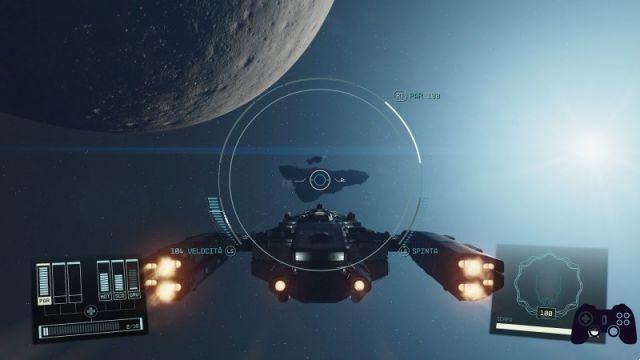
The feeling of discovery, Bethesda's historical trademark, has completely changed due to the nature of the project, definitively giving way to a new interpretation: if to reach the most interesting, unique and hand-designed destinations, it is necessary Move passively chasing quests and pins on the map. stellar, the cities and main points of interest are instead revealed as labyrinths full of contextual dialogues and interactions that never stop pursuing the protagonist, literally throwing themselves into his arms. It is enough to take a few steps in the slums of the city of Neon, for example, to find in our hands an exaggerated amount of clues and experience dozens of original circumstances, revealing an offer that in terms of raw content embarrasses most. historical productions of the house. To achieve this, however, Bethesda sacrifices exploration, outlining a kind of Skyrim without a world to discover, without an organic link between points of interest, in which progress is only made through fast travel.
L'balance between density and rarefaction It is, therefore, precarious: in the hundred star systems that it is possible to visit, the place worth mentioning is a grain of sand in the middle of many practically deserted planets, while to reach them it is not necessary to curiously navigate between stars. and valleys, but they go through a series of menus and loads.
Storytelling and quests: Constellation is just the beginning
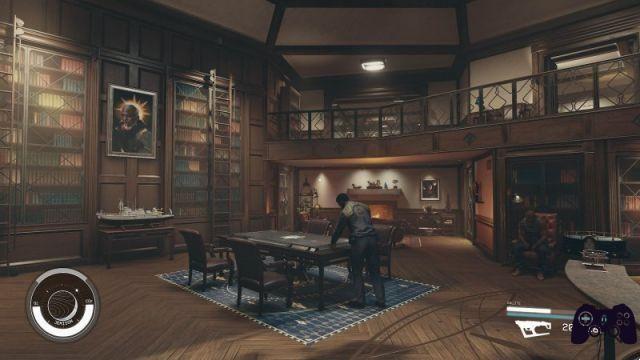
The call "main plot"has never been the center of gravity of Bethesda's works, always presenting itself as a subtle red thread destined to unite the foundations of the virtual world, normally the real and undisputed protagonist of the experience; in the Milky Way, however, things are slightly changed. Starfield has made a smart decision, transforming the central story into a pretext to transport players to the four corners of the Colonized Systems. After having created your own alter ego and experienced an introduction far removed from the dynamics of power fantasy, you find yourself In fact, you find yourself in the presence of Constellation, the last bastion of the most classic space explorers: always in search of the unknown, this heterogeneous group is on the trail of a series of mysterious artifacts related to strange gravitational anomalies, and it is precisely this investigation that weaves the great canvas of the narrative: there are no imminent cosmic threats, there is no predestination, there is no specific mission that the protagonist must urgently fulfill: what is asked of the members of Constellation is simply explore the cosmos without establishing any framework. boundaries, without following any rules, gathering as much information as possible about the unknown artifacts.
The other members of Constellation, including potential companions with romance and dedicated missions, thus fulfill the role of the interstellar Virgil, introducing the player to the centers of power, the customs of the different factions, and the dictates of the new religions they have made their own. path to colonized systems. If, in some ways, this may seem like a rushed and bland narrative premise, the truth is that it allows you to perfectly embody the background and fantasy that you have chosen to embroider around your character. You don't have to take on the role of bastion of the common good like the Dragonborn, there's no cumbersome revenge like the one at the center of Fallout 4 - these inspirations fade away completely to leave center stage to the freedom to be anyone. you want to be, do what you want to do. Then, once it took flight, the writing reaches greater heights compared to Bethesda's previous works, also staging some sections of great depth, before resolving in an unexpected way new game+ - perfectly integrated into the narrative - among the most intelligent found in recent times.
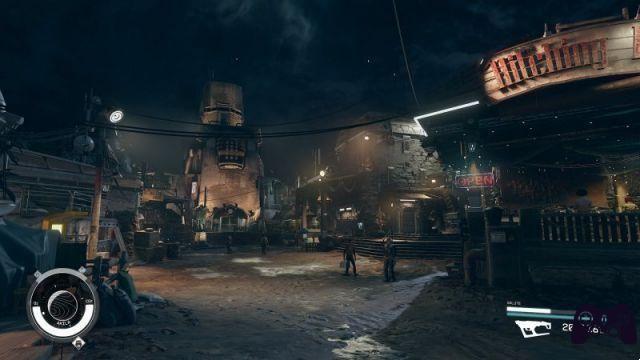
As is tradition, the ocean of stars becomes a storm of input: a walk through the streets of any settlement is enough to open up a wide range of opportunities, effectively hiding dozens of hours of entertainment behind each encounter. Some of these side missions They acquire characteristics of small autonomous science fiction films, not without twists and turns: is the transmission of a distress call intercepted? That encrypted message could become a fast-paced action film in which two opposing military groups remain prisoners in a base on the surface of a planet; Do you come across a ruined orbital station? Once docked, it could be a kind of miniature Alien, or perhaps an homage to 2001: A Space Odyssey, or even a reference to Futurama. Much of what is lost on the active exploration front returns to the rare banks crafted by Bethesda, which has partially evolved its original recipe: secondary classics can now be considered finished science fiction stories, but they remain surrounded by many variations and insignificant procedural activities. designed to last forever.
Where the work comes to give its best is in the orbit of four main factions, segments that stage very long adventures full of choices, deep interactions, well-characterized characters, often hidden from less attentive eyes, as happened in the past with the Dark Brotherhood, each of them willing to delve much deeper into the fabric of world-building, featuring excellent gameplay sequences and views impossible to find elsewhere. Between endless investigations with noir overtones and very dangerous covert operations, in which the idea of joining the dark side is specifically contemplated, is the highest peaks of the production, both in terms of storytelling and co-stars, as well as the moments in which Starfield finally manages to touch upon its grand ambition: that of accommodating alternative existences between the arteries of a receptive, expertly written world.
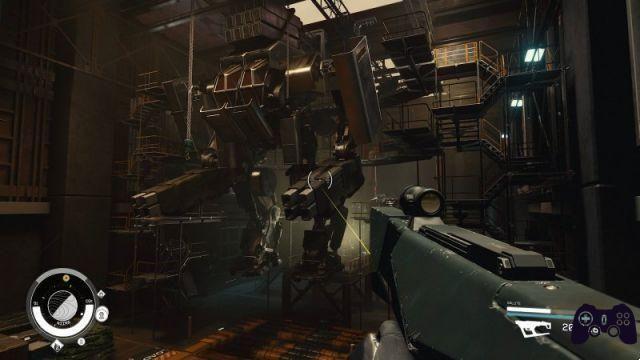
Once the idea of outlining an "important" protagonist is shelved, it is up to each player to build their own story, starting with the selection of a fondo which determines the skills you are most familiar with; We opt for Ronin, an expert in stealth and melee weapons, discovering with pleasure that the mere acquisition of certain benefits is reflected in the options available in the dialogue phase, a bit like what happened on the shores of Fallout 3. This concept is significantly evolved by si chosen, or a maximum of three specific characteristics that have considerable weight in the experience economy: by selecting "Neon Rat", for example, the protagonist can exploit all the experience gained in the alleys of that particular city to reveal quests additions and various fixes that would otherwise be inaccessible, in a decidedly more effective way than the timid origins of Cyberpunk 2077 represented.
The great positive note is that this inspiration is also reflected in the character growth, to the point that completing faction events results in more dedicated interactions, for example transforming what would normally be enemies into unlikely allies, or increasing options in certain circumstances. The weight of the decisions, on the other hand, maintains the proverbial relativity of the studio's past adventures: the shocking options increase and the evil alignment receives decidedly more support - especially when it comes to the factions - but even though the work is peppered with pleasant exchanges and unique dialogues, the game world still does not respond convincingly to the player's actions, which only rarely leads to strong consequences in the grand scheme of the adventure. In short, it is the usual universe in which it is possible to be a policeman and a thief, a hero and a murderer at the same time, in which everything almost always returns to its original state, designed to allow anyone to experience what the environment has to offer. without asking for limits, not even those of coherence and depth.
Gameplay: a galaxy of possibilities
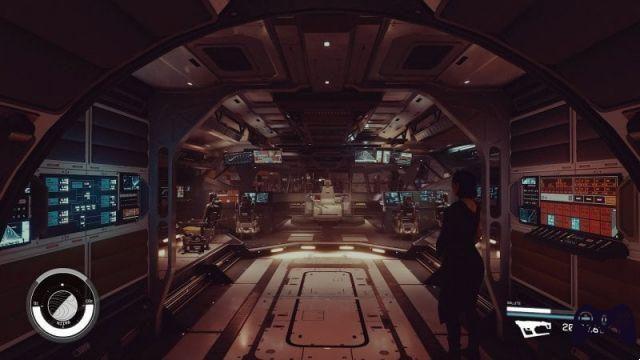
The first consideration to make when talking about Starfield's gameplay is that in Colonized Systems you shoot, and you shoot a lot. Before publication, the developers talked about the impossibility of completing a complete game as a pacifist and the reason is very simple: at its core, the packaging by Bethesda is still aexperience strongly rooted in action. Space pirates, mercenaries, crazed robots, alien insectoids: hordes of enemies of all kinds patrol the depths of mines, the corridors of war laboratories, the old disused armories, transforming shootouts - or the most cautious stealth infiltrations - into fundamental gears of the galactic machine. The backbone of the combat system lies in it handle structure of Fallout 4, slightly refined to add a pinch of dynamism to the confrontations and, above all, to shake off the last wooden residue of the Creation Engine, creating a more fluid and responsive amalgam. The mere presence of the boostpacks that allow maximum use of verticality, as well as that of the zero gravity zones in which the recoil of the weapons is physically felt, effectively changes the focus of the confrontations, taking on the challenge of a design of the levels that manage to reward the imagination.
Before we dive into analyzing the mechanics, we must applaud the company's creative team, which has raised the bar in terms of map structure, creating arenas that adapt to the classic needs of the action and mazes of ventilation shafts that promote the stealth approach, concretely allowing you to attack different situations in different ways, perhaps without firing a single shot and simply breaching the security systems of the structures . Unfortunately the same cannot be said for artificial intelligence, which has remained firmly anchored in the simplest routines of the past, constantly busy seeking refuge right in front of the avatar in an attempt to discharge the magazine without any jolt. . Flashes that, on the other hand, are reserved for the player, who can roam freely among a very rich arsenal of weapons and equipment, from laser rifles, through the old weapons of the old company, to absurd pump grenade launchers, improvised mining drills, Japanese swords and dozens of other options, all convincingly designed, also taking inspiration from Destiny's aesthetic regarding unique variants.
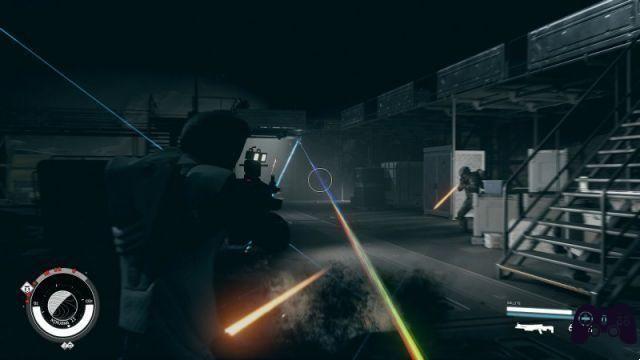
It goes without saying, in this regard, that looting and presence of loot They form a fundamental element of the recipe, opening up the now inevitable equipment rarity system, as well as an endless list of clothing, helmets, spacesuits and backpacks equipped with unique features that have a superficial impact on the gameplay. It is a system framed by a skill tree that represents a cocktail between the past and the future of the house: each "perk" in fact has different degrees of effectiveness, and to access the higher ones it is necessary to complete a series of tasks specific. challenges; a random example? To increase your stealth capabilities it is not enough to assign points, but you will also have to kill a certain number of enemies who are unaware of your presence. Rather than being limited to flat stat boosts, these abilities include classic particular options, such as the ability to mentally control an enemy and force them to perform any action you wish, as well as a multitude of passive abilities dedicated to scientific research, crafting weapons and obviously everything that orbits around spaceships.
The architecture of flight system embodies a simplification of the simulation DNA found in the backgrounds of Elite: Dangerous, effectively transforming veterans of Frontier's work into relentless death machines. In case you are not familiar, this structure revolves around the real-time management of the ship's energy, which can be manually assigned to the various critical systems, namely the armament, thrusters, deflector shields and the gravity drive. ; This means that, for example, diverting all the energy from the jump motor to the thrusters will allow you to fly faster, sacrificing the ability to escape in case of danger. The result is a dance in the middle of the asteroid fields punctuated by the roar of laser cannons and Gatling turrets, an immediate and sufficiently deep construction that stages "aerial fights" in which the experience of a single pilot always wins. , along with military supremacy. on numerical superiority. Although the sections on board the ship are less present than expected, these mechanics fulfill their duty perfectly, to the point that Bethesda has chosen to reward them with dedicated activities, for example a series of confrontations with legendary ships that drag between the stars are the legacy of the galleons of Assassin's Creed: Black Flag.
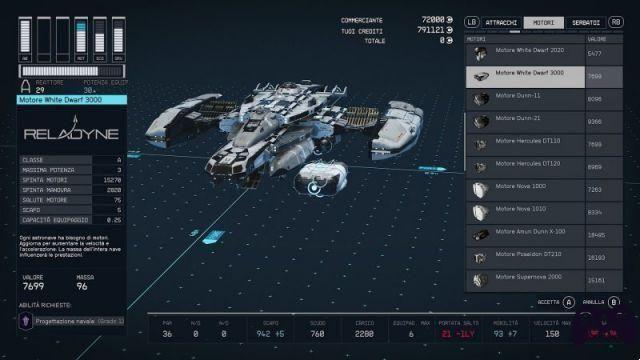
Where the house scored a perfect cross is in front of the spaceship construction, creating a very deep editor that is not limited exclusively to aesthetic customization and increased performance, but is directly reflected in the architecture of the ship's interior, for all intents and purposes a second home in space. For enthusiasts it is a godsend: naval authorities make available hundreds of different weapons, cockpits, unique modules and decorative elements, establishing the only iron rule in installing a reactor powerful enough to power the fundamental components. There are no limits to what can be achieved, as even the most damaged car is completely modular, while the galaxy is full of unique variants that can be recovered and renewed quickly and intuitively, according to a formula that also adapts perfectly to the needs of those who have difficulty digesting creation systems. Not to mention, for those who really hate the design, the ability to buy spaceships at major spaceports, steal them after battles, and even just auto-upgrade critical modules has been built in, celebrating a maxim at the core. of the new Bethesda universe: you are always free to do - or not do - what you want.
A constant, this one, which is at the base of brewing system, a moloch that relies on the presence of hundreds of resources before developing through technological research, weapons engineering, pharmacology, but above all the construction of entire planetary outposts. Having learned the hard lesson of Fallout 4, the studio made the right decision to make this huge device completely optional, giving any fan the possibility of setting up extraction centers and military bases, spaceports and dream settlements, but above all do it whenever you want. wants, how he wants, where he wants, or even not doing it at all. However, there is a side effect, which is hidden precisely in the need to collect tons of raw materials: the desire to undertake a long-lasting and meaningful adventure was reflected in the need to dedicate oneself to agriculture sessions intended for the collection of minerals, complex materials but also simply credits, all fundamental resources and often difficult to find, to the point that they become a very important piece in the mosaic of progression.
Structure and technique: the timid evolution of an old recipe
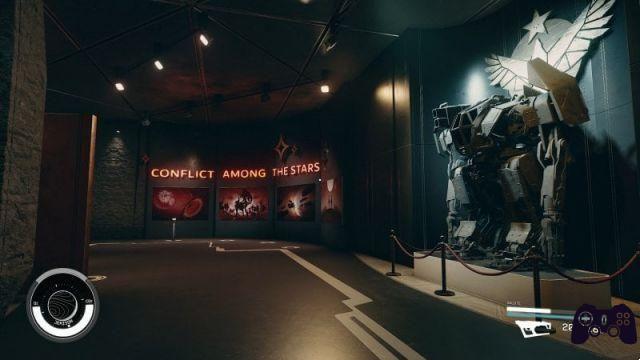
"Skyrim in space". The definition chosen by Todd Howard to describe Starfield to the general public is undoubtedly fascinating, but it also presents problematic implications: although it is now remembered as an extraordinary success, we must not forget that the fifth chapter of The Elder Scrolls saga is still a video game from 2011. And there is no doubt that Creation Engine 2 remains an engine still deeply rooted in most of the limitations of its predecessor, but it has managed to transport Bethesda's artistic inspiration into the future. It is an experience graphically excellent, perhaps not excessively refined in small details such as the foliage of the vegetation, but capable of offering impressive views and extremely detailed interiors, making among other things impeccable use of the dynamic lighting system, which manages to completely change the aesthetics of the planets. depending on the time and place you choose to land, with some spots only in the shadows. A meticulous investigation, which is found in each element of the aesthetics, between the materials of the suits, the finishes of the ships, the furniture of the structures and, above all, the planetary surfaces, the true protagonists of the renovation process.
And it is a result that is achieved by making few compromises: Starfield is, without a doubt, the most technically refined title in the history of the American house, stained by a small number of failures - practically all visual - and solid on Xbox Series it only occurs in a very specific place to suffer obvious drops below 30 fps, while occasional slowdowns tend to noticed only at the end of the adventure. The delicate point is in the Xbox Series S, a machine that, on the one hand, effectively takes advantage of dynamic resolution to ensure a good overall experience, solid most of the time, but on the other hand tends to fail. too frequently after fast travel and zone changes: in about twenty-five hours of play on the smallest console we find ourselves faced with at least a dozen unexpected closures, a situation that should improve significantly with the first day patch. The only notable stumble is found in theinterface, specifically the star map in four levels: there is no way, at the moment, to find a planet visited in the past without manually checking all the systems, in the same way that it is not possible to carry out any type of research or place pins. , making navigating the menus very cumbersome in some cases, not to mention that it is not even possible to sort the missions in the diary according to where they take place.
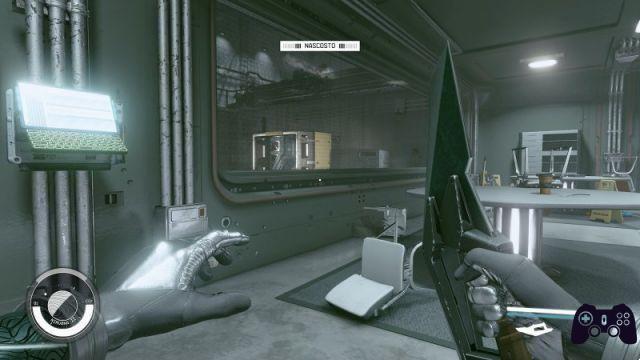
On the sidelines, the work is dotted with many small remnants of the classic structure of the proprietary engine, such as the omnipresent loads that design intermittent exploration, the NPCs that lose any hint of life once the tasks in the missions are finished. have been completed, or even the enemies, who don't do much more than take cover and run towards the protagonist. But these have always been trademarks of the studio, small bad habits that we tend to forgive easily in the context of majestic experiences. The difference, in this case, is that the new interstellar scenario, together with all the mechanics that derive from it, runs the specific risk of erode essential elements of the soul of Bethesda, above all the charm of exploration, the excitement of discovery, but above all the organic staging of a world that over time you learn to know as if it were your own home.
Despite this, Starfield looks a bit similar Grandma's old recipe., that very particular dish that was eaten on Sundays: a traditional and genuine meal that cannot and does not want to compete with the technique and modernity of a restaurant, but that despite its obvious defects manages to carve out a space close to the heart. Bethesda has thrown its ancient philosophy into the middle of a sea of planets, offering fans hundreds of hours of entertainment that have always marked their worlds, without, however, managing to provide substantial innovations or look with curiosity beyond its own limits. past, leaving us with our feet firmly anchored to solid ground and leaving these tasks in the hands of the modders. You can choose to observe this nature with severity, overcoming the shortcomings, or abandon yourself to a new creative inspiration, accepting all the limits and rules of the case to receive in exchange the opportunity to live a second virtual life, this time among the stars. .
Conclusions
Tested version Xbox Series X digital delivery Steam, Xbox Store Price 79,99 € Holygamerz.com 8.5 Readers (264) 8.5 your voteStarfield is a colossal adventure that projects the experience acquired by Bethesda artists into space, transferring all the great qualities, but also the weaknesses, of historical creative philosophy to the framework of science fiction. This is not an experience that allows you to sail in real time towards the infinite and be enchanted by the sensation of discovery, but rather a vast, down-to-earth role-playing game, stitched directly into the ancient Elder Scrolls formula. , capable of providing hundreds of hours of entertainment to anyone who is willing to accept its rules and limits. The great improvements that have affected the narrative and technical component, along with the extraordinary number of activities offered, are in fact mitigated by disorganized exploration, by the proverbial static nature of the world and by some residue of the old Creation Engine. Overall it is a huge and very high quality video game, a treasure chest containing the classic alternative life that Bethesda offers, but the interstellar nature and crude dimensions risk weakening the house's recipe.
PRO
- Incredibly packed with activities and virtually endless thanks to mods.
- Excellent world setting, exceptional artistic design and stunning views.
- The plot and faction writing far exceeds Bethesda standards.
- Graphically remarkable and technically sound, with almost no bugs.
AGAINST
- Fully passive exploration based on fast travel, loading and scenes.
- The structures of the planets are repeated identically to infinity.
- The formula in space and its size hurt some of Bethesda's greatest strengths
- The world remains excessively static due to the player's decisions.




